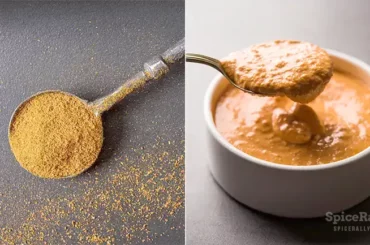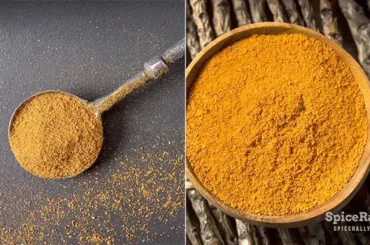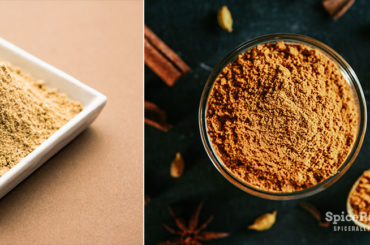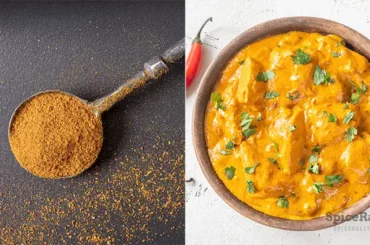Masalas are nothing new to Indian cuisine since each household uses them in daily cooking. So, in this article, let’s bring some valuable details on biryani masala vs Garam Masala that you longed to learn about!
The most common and apparent difference between Garam Masala and biryani masala powder comes down to their textures. Biryani masala powder is often a little coarser, while Garam Masala is always a fine powder. Moreover, biryani masala powder is more focused on its aroma, but Garam Masala is known for its flavor and depth. Accordingly, they are different in terms of usage, color, etc.
Continue reading as we hope to break down more differences between these two spice blends, digging deeper into each of them.

| Biryani Masala Powder | Garam Masala | |
|---|---|---|
| Base flavor | Warm and spicy | Warm and spicy |
| Main ingredients | Star anise Caraway seeds Green cardamom Black cardamom Cloves Coriander seeds Fennel seeds Cumin seeds Kashmiri red chiles Bay leaves Black peppercorns Mace Nutmeg Cinnamon Variations might also include the following: Turmeric powder Garlic powder Onion powder Ginger powder Salt Dried plum Unripe mango powder Muskmelon Artificial colors, flavor enhancers, and preservatives Citric acid Anti-caking agents | Green cardamom Coriander seeds Cinnamon Black cardamom Mace Bay leaves Black pepper Fennel seeds Cloves Cumin Nutmeg You may find many variations of Garam Masala depending on the region and household, and these variations might include the following: Star Anise Ginger Garlic Caraway seeds Kashmiri red chiles |
| Flavor and aroma profiles | Biryani masala powder has a deeper aroma profile than Garam Masala. Can be spicier if additional spices like garlic powder and ginger powder are included. However, biryani masala powder is generally earthy and warm, with zesty overtones. | Garam Masala is less aromatic when compared with biryani masala powder. The flavor profile of Garam Masala largely depends on the ingredients used. However, it usually has a warmer, deeper, and earthier flavor. |
| Heat and spiciness | Can possess a more heaty note due to the fundamental addition of red chiles. Spiciness depends on the proportion of ingredients used. | Can be spicier but less heaty than biryani masala powder. But the spiciness can depend on the ingredients used. |
| Texture | Generally slightly coarser than Garam Masala/ | Always comes as a fine powder. |
| Color | Light brown or orange in color. | Deeper in color than biryani masala powder, ranging from light to dark brown in shade. |
| Mode of usage in cooking | As an ingredient. | As an ingredient and a finishing spice. |
| Usage in cooking | – Used primarily in making various biryani dishes. – It can flavor up meat, fish, and other seafood dishes. – Jazzes up gravies and curry sauces. – It adds flavor to dal, grains, and eggs. – It can be used as an ingredient in rubs and marinades. | – It doesn’t limit to one particular type of dish. – Commonly used with meat and fish curries – Flavors Indian-style egg recipes – It is incorporated into a variety of ground meat recipes – Ramps up several vegetable and vegetarian dishes. |
| Variations | Many variations exist depending on the region, type of biryani, household, or production. | Many variations exist depending on the region, household, and production. |
| Origin | Indian cuisine | Indian cuisine |
| Availability | Widely available across India and can be bought under several brand names outside of India, from the international spice aisle of the supermarket, Asian stores, and online shopping sites. | Widely available across India and can be bought under many brand names out of India in any supermarket, Asian stores, grocery stores, and online vendors. |
| Storage | Can be stored in a well-fitting glass container with the rest of your dry spices, herbs, and blends. Refrigeration is not required and it should be kept away from direct sunlight, humidity, and moisture. | It can be stored in a well-fitting glass container with the rest of your dry spices, herbs, and blends. Refrigeration is not required and it should be kept away from direct sunlight, humidity, and moisture. |
| Mode of production | Commercial and homemade versions exist. | Commercial and homemade versions exist. |
More Insights Into The Difference Between Biryani Masala Powder And Garam Masala
Different types of masalas tend to confuse many, especially if you are a beginner learning about Indian cooking. The many ingredients used are similar, so we hardly recognize any differentiation between them.
But in reality, they both possess subtle differences that are worth getting our attention while we work with Indian cooking and incorporate them with our dishes. As you see, The minor texture difference is the most apparent distinction between biryani masala powder and Garam Masala. Biryani masala powder is a spice blend known for its fragrance.
The coarsely ground spices and herbs in this spice blend work wonderfully, maintaining these elements for a long time in the biryani dish. But you’ll sometimes find finely powdered biryani masala powder variations as well, especially when you buy them from the shop.
On the other hand, Garam Masala always comes as a well-pulverized mixture. Unlike biryani masala powder, Garam Masala is also used as a finishing spice in certain dishes. Therefore, the fine powdery consistency helps to finish those dishes with a pleasant aroma and an added flavor.
Ingredients and Variations Differences…
Both spice blends do not confine to standard recipes since both vary depending on the household, region, and production. Although we don’t see a considerable variation across biryani masala powder, every Garam Masala recipe tends to be different from one another.
However, biryani masala powder variations like the Hyderabadi mixture include more aromatic and exotic ingredients like Marathi Moggu and black stone flowers, which you don’t typically find in Garam Masala. Moreover, biryani masala powder also includes red chiles, which are hardly used in Garam Masala.
Can Garam Masala Be Used In Place Of Biryani Masala Powder And Vice Versa?
Differences apart, biryani masala powder and Garam Masala possess a set of similar ingredients with a considerably comparable flavor profile. For this reason, we can see some people even using Garam Masala when preparing their biryani recipes.
This is mainly because of the versatility of this blend and its accuracy with the bulk of the ingredients. But, you may not be able to use biryani masala powder in every recipe that originally calls for Garam Masala.
For example, biryani masala powder is not a favorable choice when you need to replace it with Garam Masala as a finishing spice. Thus, Garam Masala and biryani masala powder can be used interchangeably, but with exceptions, only on limited occasions.




